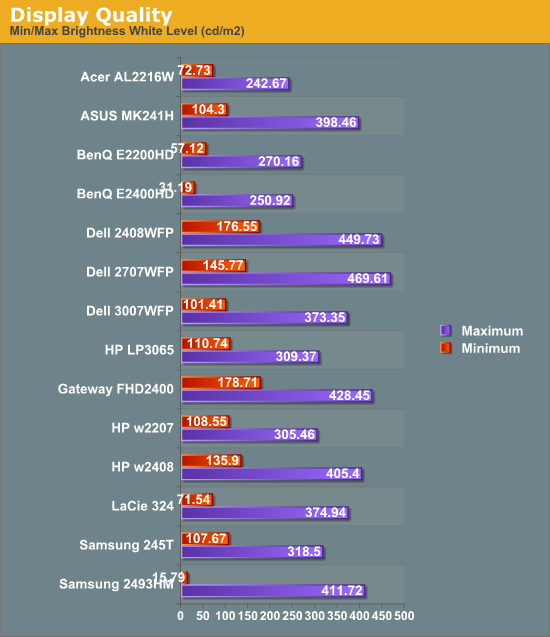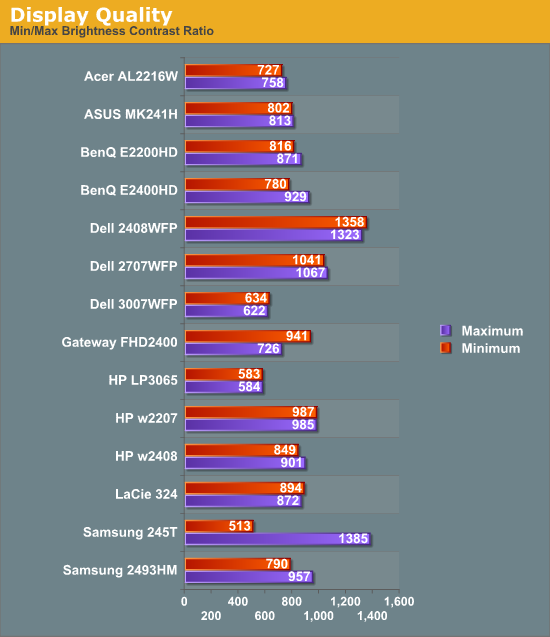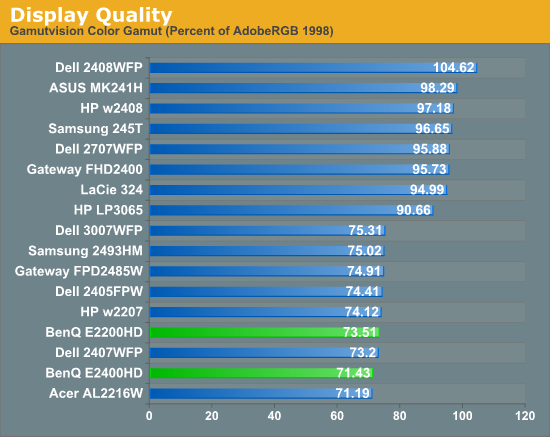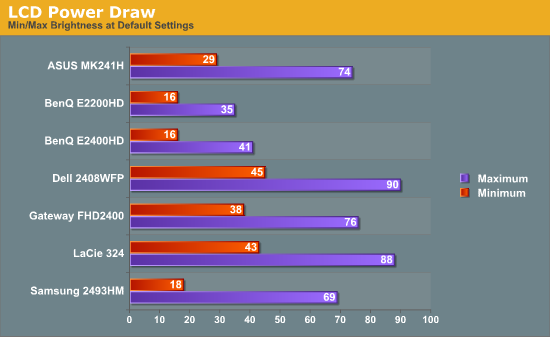BenQ E2200HD and E2400HD - 1080P FullHD LCDs
by Jarred Walton on November 4, 2008 5:00 AM EST- Posted in
- Displays
Brightness and Contrast Ratio
For the brightness (luminance), contrast, and color accuracy tests, we depend on a hardware colorimeter and software to help calibrate the displays. We use a Monaco Optix XR (DTP-94) colorimeter and Monaco Optix XR Pro software, and we also test with ColorEyes Display Pro. Results in nearly every case have been better with Monaco Optix XR Pro, so we only report the ColorEyes Display Pro results on the monitor evaluation pages. We'll start with a look at the range of brightness and contrast at the default LCD settings while changing just the brightness level. (In some cases, it will be necessary to reduce the color levels if you want to achieve a more reasonable brightness setting of 100-120 nits.)



The two BenQ LCDs have a maximum brightness level of 250-270 nits, which is more than sufficient and is actually brighter than what most users prefer to use in an office environment. If you want to reach the advertised 300 nits brightness setting, you will need to adjust contrast and/or color levels as well. Minimum brightness at default settings is 30-50 nits, so there's typically no need to fiddle with color levels.
More important than the luminosity is the contrast ratio that is achievable at the various brightness settings. Depending on setting, we measured a contrast ratio of 780~930 with these LCDs. While higher scores are better, in reality anything above 700 is more than sufficient for most users. The Dell 2408WFP tops our charts, but this is mostly a victory of marketing numbers. Also, we wouldn't worry about any advertised dynamic contrast ratio numbers -- at least not if you want consistent colors.
Color Gamut
We've already shown color gamut for the LCDs, but here's a chart showing how the LCDs stack up against each other. We use Gamutvision, a utility developed by Imatest LLC to calculate color gamut. We compare the color profiles of the LCDs to the Adobe RGB 1998 color profile and report the results as a percentage.

So far, color gamut has generally fallen into one of two categories: either +/-95% or +/-75%. The BenQ E2200HD and E2400HD target the budget market, so it's not too surprising that color gamut is lower than many competing models. However, it's important to keep things in perspective: these results may seem very low, but if you are using the standard sRGB profile (Windows' default) these LCDs look fine. It's only in applications like Adobe Photoshop with its improved color space that you begin to notice a difference between the displays.
Power Requirements
We also look at power requirements, but we've changed our testing procedure somewhat since previous article. Minimum power requirements are going to depend largely on how dim the backlight is at the minimum setting, so a display that only puts out 16 nits at minimum brightness should logically use less power than one that puts out 50 nits. Since very few people will run an LCD at less than 100 nits, we tested at that level, as well as our standard 200 nits that we use for calibration, and finally at maximum brightness setting using default color and contrast settings. Since we changed testing procedures, we don't have equivalent information for any other LCDs yet, so we included a chart showing min/max power draw as well (our previous power test). We will report the new results in a table, along with brightness and contrast ratio information at the various settings.

| Power, Brightness, and Contrast Levels | ||
| BenQ E2200HD | BenQ E2200HD | |
| Maximum Power Draw | 36W | 41W |
| Maximum White | 270.16 | 250.92 |
| Maximum Black | 0.31 | 0.27 |
| Maximum Contrast | 871 | 929 |
| Calibrated Power Draw | 29W (66%) | 34W (73%) |
| Calibrated White | 199.3 | 199.23 |
| Calibrated Black | 0.23 | 0.22 |
| Calibrated Contrast | 867 | 906 |
| Print Power Draw | 20W (20%) | 24W (30%) |
| Print White | 100.03 | 99.34 |
| Print Black | 0.11 | 0.11 |
| Print Contrast | 909 | 903 |
Looking at just the two BenQ LCDs, it's no surprise that the larger E2400HD consumes slightly more power. Perhaps more interesting is that many old 20" CRTs could draw 100W or more and only attain a brightness level of ~120 nits. That's one more reason we prefer LCDs (along with a lot less strain on our backs when moving displays around). Even at maximum brightness, the BenQ displays both use less power than the other LCDs we've tested, but those displays may have been brighter so we can't make any definite conclusions about "greenness".










33 Comments
View All Comments
shithead3656 - Tuesday, March 31, 2009 - link
Very nice revie. I only read the e2200hd review bcoz i plan to buy that model once my 17" CRT goes BOOOOM. xDAnyways, I wish you guys can review the Samsung 2233SW(which is benq's E2200's rival)(Guys, i know the samsung has no speakers and HDMI, but usually monitor speaker ain't good and you can buy HDMI>DVI converter). But im my contrie, Samsung 2233SW is steadily going up in price, so bcoz of that I'm also looking at Samsung 2033SW. I will be waiting. And you guys at anandtech ROCK!
swordenium - Friday, May 1, 2009 - link
Go for the 2233SW!! or preferably Its older bro 2243SWX which has more features and includes a DVI cable!!! Both Asus Vh226H and Benq E2200HD are gr8 monitors for price yet Image quality and colors(too unnatural Benq) leaves a lot to be desired!!!! so so......but Samsung 2233SW (reviewed by techtree and pcworld)and 2243SWX are accurate in colors!!! and have awesome IQ!!! Just it lacks HDMI input! which I dont care!! DVIs handle HD resolutions well!! of course, u have a hdmi to dvi converter!!tofool - Monday, February 23, 2009 - link
how do you remove the base stand as pictured in the article?Jalamari - Monday, February 23, 2009 - link
hi i had some trouble with the base stand too but got it finaly.the screws holding stand are behind the small silver plastic piece where the monitors tilts, it has 4 clips on top and bottom so you should be able to remove it by squeezing the plastic from top and bottom and pulling it away from monitor if its too tight try to help it with flat screwdriver
virtuoso5 - Monday, December 1, 2008 - link
Is it true that this display does not work good with 720p signals?I wanted to buy this to connect also the Playstation 3 and most games are 720p (the console makes no upscaling to 1080).
zzzxtreme - Monday, December 1, 2008 - link
I just tested connecting my laptop to a 32" Samsung 720p LCD TV through VGA. LCD TV's brightness are typically from 450nits-500nits.It is freaking beautiful. You get all the quality panels and chipsets.
The days of monitors are over.
Benyss - Sunday, November 30, 2008 - link
Please HELP. Benq 2400HD ror PS3? Yes or No? Thanks.Tonyjr - Wednesday, November 19, 2008 - link
They further dropped the price of E2200HD for "early black friday" $209 promo code "E2200HD".Cashmoney995 - Monday, November 10, 2008 - link
The best thing that I have going on in my APT is my cheap 12$ VGA clone box I got from monoprice. I currently have my 16:10 1680x1050 display cloned to my Samsung 50 inch LED DLP tv in my living room. Added in a wireless kb and mouse and I can access the same computer in my office in my living room. Ahh the beauty. EXCEPT that 1680x1050 has some weird cut offs on the DLP. With a real 1080P monitor I can clone my desktop perfectly on the tv.nubie - Wednesday, November 5, 2008 - link
I am looking for a real 1080p display for about this price as a TV, but the lack of 1080i or 720p support is kind of a deal killer.I am just assuming 1080i isn't supported, but what do I know?
If you have a tuner/DVD player that will support 1080p output then I would love to use this screen. Pixel splitting is a pet peeve of mine and I love the crispness of a 1:1 source and display ratio.